Faust and the Faustian are at the heart of Clark's motto, "Challenge Convention, Change the World." We're interested in how this fifteenth-century, small-town German necromancy caught the attention of so many writers, artists, and musicians, including Marlowe, Goethe, Bulgakov, Mann, Havel, Liszt and Gounod.
Monday, November 29, 2010
Liszt: Faust Symphony and Dante Symphony
Allow me to share with you a symphony by one of my favorite pianists/ composers- Franz Liszt
Now, not a person remotely talented musically, or educated beyond a few years of flute, I consider myself still able to appreciate a good tune.
The Faust and Dante Symphonies, ladies and gentlemen, by Franz Liszt:
(I like the fact that geeks and composers have helped us reach a point where we can embed entire playlists as flash frames. Just keep clicking next above to listen to the full thing.)
Sunday, November 28, 2010
Dante and Goethe

I have started (and will most likely finish over Winter Break) Dante’s Inferno, the first part in The Divine Comedy. It is a classic that I have wanted to read for some time, and now I have finally allowed myself to make my nerdy dream come true. After reading the first Canto, and snooping through some of the commentary provided by the editor, I realized how Faustian this book is.
Evidence in Canto 1:
First line Dante is traveling through the “Midway on our life.” Like Faust, he is Middle-Aged and restless.
Dante cannot handle his restlessness, thus, he “found” himself “now searching” in line 4. Also like Faust Dante has a strong thirst for knowledge, something new.
Further on in the Dante finds a savage Beast. The feline beast is Unfaustien because it “blocks progress”. I interpret the Beast represent the lethal politics of the Catholic Church. Dante was exiled from Florence in 1302 due to his political beliefs that the church found unsavory. This large feline is chasing him, and Dante fears for his life, but he is rescued by the poet Virgil. When Dante meets Virgil, he is Star struck. It would be as if I meet Margaret Cho, or Professor Tobin met the Ghost of Herr Goethe. Dante meets his literary inspiration, his hero. Or, as he puts it “the light and glory of all poets” in line 82.
In the next line, 83, Dante talks about his “ceaseless care” in his study of Virgil’s poetry. The element of Care allowed him to study Virgil’s poetry, to open Dante’s eyes. In the story of Faust, on the other hand, Care blinds the protagonist. Another interesting difference in this story is that Virgil is sentenced to live on the outskirts of hell, where as Mephisto works in hell. The guide in Dante’s story is captive, where as the guide in Faust’s story is a collaborator.
Another interesting similarity (outside literature and present in the author’s realities) was the fact that there were both politicians. (Goethe in real life and Dante in real life).
Sunday, November 21, 2010
Exorcising the Devil from Thomas Mann's "Doktor Faustus"
Last week I talked about Karin Crawford's article Exorcising the Devil from Thomas Mann's "Doktor Faustus"
A write up on my presentation can be found here.
A link to the article on JSTOR can be found here.
During class time, we had a guest lecture from Professor Korstvedt from the Music Department on dodecaphonic music and we listened to pieces from Schoenberg.
By Thanksgiving we should hand in our creative writing pieces, based on pp. 382-283, the Thomas Mann style characterizations. We should also be beginning our research for our papers!
Have a great Thanksgiving everyone!
Tuesday, November 16, 2010
The Overwhelming World of Faustian News Articles
Here are links to some of the articles, categorized and with a brief description. If nothing else, it’s a good way to keep up with some current events!
Politics/History/Science:
Scientists, officials and others once affiliated with the Nazis were allowed to come to the United States after World War Two and contributed to important scientific developments.
The pros and cons of energy sources
Geoengineering
The Pakistani-American political relationship
Entertainment:
Scary celebrity children taking over the entertainment industry
Chelsea Handler’s new publishing imprint
Sports:
Payment of college athletes
Yankees players’ high salaries
Sunday, November 14, 2010
Dare by Abiola Abrams
This is the book I was talking about in class - the African American Faustian novel :-)
This is the link to Abiloa Abrams' homepage where you can find out more about her and the book and the story behind the story!
Wednesday, November 10, 2010
FiredUp Presentation
Women Characters in Doctor Faustus
Brigitte Prutti
1. The Mother Figures
Elsbeth Leverkuhn: We have a maternal figure not included in the classic story of Faust. In Adrian’s childhood world, music is manifested on a personal level concerning both mother and stable-maid.
While Mother uses her voice with restraint, Hanne is unbound by reservations. The motif of the “stable-warmth” of music returns to his childhood influence.
Adrian’s musical history begins with this system based on simple melody and its repetition.
There is also an episode when Mother Faust is speaking with the music teacher Kretzschmar: she is possessive of her son while he wishes to “fling himself into the arms of music.” -----Here music substitutes maternal love by portraying how Mother Faust is jealous of the musical “bride” that is to replace her.
Mother Schweigestill tells a story that closely resembles Adrian’s own experiences. About a girl who wants to be seduced and is willing to sacrifice her life for the seduction. This parallels to Adrian’s willingness to be enveloped by music and the sacrifices he makes when he achieves his own seduction.
2. The Female “butterfly”
The transparent butterfly of his father’s mystical speculations about nature remain with Adrian through his childhood memories when he calls the prostitute “Esmeralda”.
The inspiring Muse, the “eternal feminine,” becomes an agent of the poisonous “angel,”, the devil. The social inversion makes a prostitute out of a seemingly “heavenly Muse”. By having sex with the diseased woman, Adrian gains the desired breakthrough of creative inspiration, even though this liberation comes at a deadly cost. His sexual desire becomes the sinful pact with the devil. The enhancement of his creativity via his illness requires Adrian to direct his sexual energies into art.
Her existence as a social outsider and her “otherness” are captured by the image of the exotic butterfly. As a destructive force, the woman is simultaneously the instrument of artistic inspiration.
THERE IS ALSO another thought to keep in mind: That Adrian’s attachment to music is pictured as a wedding. Adrian the female, music the male. Only after his encounter with Esmeralda, the natural genders are inverted. Adrian’s longing “demonic conception manifests itself in copulation; only after he is impregnated with the disease does he obtain his full male creative potency in art.
Without her, the conservative revolution in the music of Adrian would not be possible.
THE LITTLE MERMAID> She sacrifices her tail in order to have human legs, but every step she takes is like walking on sharp pins. She sacrifices her life for a human soul. “There are pains that one gladly and proudly take sin the bargain with pleasures so enormous, pains such as one knows from a fairy tale, pains like slashing knives, like those of the little mermaid felt in the beautiful human legs she acquired for a tail.”
3. Women of the World
Frau von Tolna: sympathizes with Adrian and supports her understanding of his work. Her gift to Adrian was a ring inscripted with a “hymn to Apollo, by Callimachus.” Apollo a Greek god can bless with healing and curse with death from his arrows.
When Zeitblom recalls Adrian’s encounter in Graz, he summons “Apollo and the Muses in order to talk about the event. Zeitblom realizes that through Arians encounter with Esmeralda, “that love and poison here once and forever became a frightful unity of experience; the mythological unity embodied in the arrow.” The relationship between Esmeralda and Tolna is their “structural identity”, their personifications of the unity of “poison” and “healing” female love, as it manifested in the double function of the god Apollo.
Tuesday, November 9, 2010
Dante's Passage at the Begining
Monday, November 8, 2010
Doctor Who
Saturday, November 6, 2010
Leverkuhn bumper sticker
http://www.zazzle.com.au/insanity_is_a_small_price_to_pay_for_brilliance_bumper_sticker-128147455910514572
Friday, November 5, 2010
Illustrations by Harry Clarke in Goethe's Faust (1925)
 I love the feel of an old fragile book. More than that I love old type. But most of all, in this context, I like intricate illustrations, rich in metaphor and skilled in their portrayal of the text, that compliment the old feel of page, text and type.
I love the feel of an old fragile book. More than that I love old type. But most of all, in this context, I like intricate illustrations, rich in metaphor and skilled in their portrayal of the text, that compliment the old feel of page, text and type. I stumbled upon (I mean literally, not by way of any memory-hogging toolbar) a copy of the 1925 New York edition of Goethe's Faust printed by Arden Book Company.
What is special about this particular edition, you ask?
Well, this is the edition which contains Harry Clarke's illustrations.
Here are samples that I took screenshots of:
(Click on the images to enlarge.) And please DO see them enlarged!



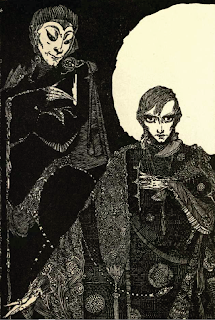



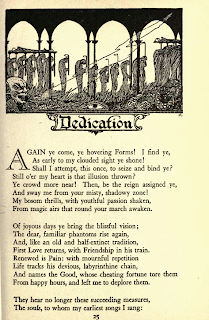
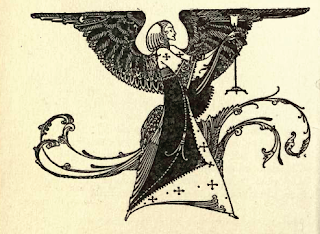

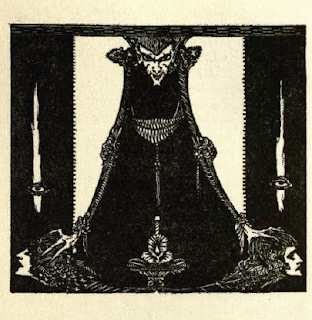

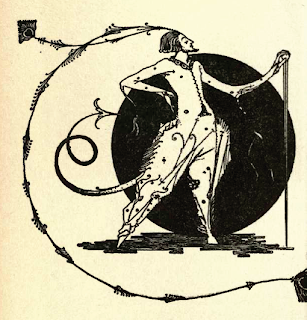
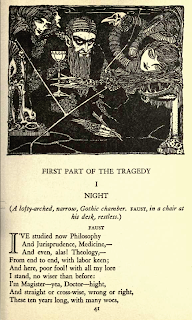

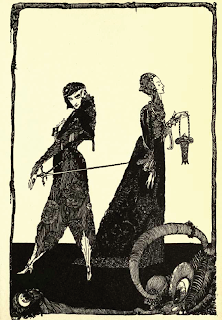
The non-copyright version is available as a PDF file from the Archive.org website. Here is the link where you can download a scanned copy of the book.
Thursday, November 4, 2010
Presentation in Class
I chose the article The Duplicity of the Devil's Pact:Intimations of Redemption in Mann's "Doktor Faustus", by Susan von Rohr Scaff for the presentation.
The Stable URL version can be found on the JSTOR database here.
My writeup on the presentation can be found here. It is a Word document that can be downloaded to your computer.
"We are lost"
"We are lost. Which is to say: The war is lost, and that means more than a lost campaign, it means that we in fact are lost-lost, our cause and soul, our faith and our history. Germany is done for, or will be done for. An unutterable collapse- economic, political, moral, and spiritual- in short, an all-embracing collapse looms ahead. Not that I would have wished for what threatens us, for it is despair, it is madness."
"...liars and frauds then prepared a stupefying poisonous home-brew. That wild intoxication- for constantly yearning to be intoxicated, we drank freely, and under that illusory euphoria we have for years committed a plethora of disgraceful deeds-must not be paid for."
Tuesday, November 2, 2010
A slight briefing on modernism and Mann's Doctor Faustus
For my presentation, my source was Thomas Mann’s Doctor Faustus: A Novel at the Margin of Modernism, edited by Herbert Lehnert and Peter C. Pfeiffer. The book is a collection of essays regarding Thoman Mann’s Doctor Faustus. In the introduction, Herbert Lehnert remarks how Doctor Faustus displays awareness of a change of an era in the 20th century; hence the book’s title regarding modernism.
The book’s notion of modernism revolves around Western society. At the beginning of modernism, religion had a strong influence on morality and social rules. This religious influence was slowly replaced by a secular morality. Modernism features rejection of the certainty of Enlightenment thinking and a revolt against conservative values of realism. Modernism features much ambiguity. Instead of presenting socially-acceptable characters, a modern novel reflects the many faces of a society. A novel playing to modernity does not subscribe to one set of moral codes.
Doctor Faustus deals with modernism as an era, the consciousness of the end of that era, and the transition to the new era of postmodernism. Mann accomplishes this by making Leverkühn be like the original Faust and having allusions to Luther and Nietzche. In the novel, Leverkühn is the modern artist, and Zeitblom is a typical middle class German. Leverkühn represents the creative mind and artistic amorality and immoral use of power. Zeitblom has all of the cultural characteristics of the bourgeois class. By having these two characters symbolize different facets of German society, Mann puts German high culture with creativity against modernist tradition, which is based on reason and guided by religion.
